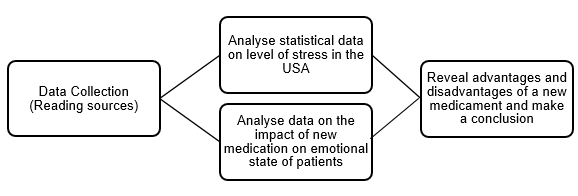Introduction
There are various methods of research in any field of expertise, and nursing is not an exception. In this essay, three summaries of literature from journals and three abstracts of studies about the methods of research in nursing will be included. Also, the differences between conceptual and theoretical frameworks will be revealed. One of the frameworks will serve as a basis for the research paradigm, which will be illustrated at the end of the paper.
Methods of Research in Nursing
Three sources related to the topic were chosen for review. The first one is the article called “Mixed Methods in Nursing Research: An Overview and Practical Examples.” The author, Ardith Doorenbos, explains the meaning of the mixed methods research in nursing, which combines elements of quantitative and qualitative research. She adds information about the four major types of mixed-methods designs explaining their benefits. The author continues her work, providing two examples of nursing research that used mixed methods. Through the examination of these cases and data analyses, the role of qualitative and quantitative methodologies was defined.
Eventually, it was concluded that mixed methods research is an excellent tool for determining transaction costs in nursing (Doorenbos 214). Therefore, the mixed methods research brings some benefits to nursing.
The second resource chosen for the review is the article “Mixed Methods in Nursing Research: Application Possibilities According to Cresswell,” written by a group of scholars from Brasil. The scholars Oliveira Joao, Ana Magalhaes, and Laura Misuematsuda, highlight the importance of research in nursing and assert that the new mixed-methods research has great potentialities. They explain the research strategy of mixed methods and explore how it can be applied in the scientific nursing field. As a result, it is concluded that this method allows scholars to obtain a more accurate and complete interpretation of data (Oliveira et al.). Therefore, this article supports the idea highlighted in the previous resource about the benefits of mixed-methods research.
The third work that will be reviewed in this paper is the article “Perspectives: Reciprocity and Integration in Nursing and Mixed Methods Research.” The author, Dawn Freshwater, asserts that research is the main tool that leads to knowledge production, which is crucial for achieving success in nursing. He mentions three paradigms of mixed-methods research, which include the dialectic, the pragmatic, and one that is related to critical realism. These paradigms, as well as various approaches in mixed-methods research, create a wealth of evidence and support knowledge production (Freshwater 329). Thus, the author reveals the advantages of mixed-methods research in nursing through the examination of its usefulness.
There are three other studies related to the chosen topic. The first one is the article “Mixed-methods Research in Nursing- a Critical Review.” The article reviews utilizing the mixed-methods research with concentration to the extent to which current practice informs researchers (Bressan 2878). The second resource is named “Perspectives: Method and Methodology in Nursing Research,” where the author explains the differences between the words “method” and “methodology” in nursing. He highlights the importance of understanding this difference in the nursing area, providing the definitions of these words (Campbell 658).
The third work is the article titled “Case Study as a Nursing Research Method: An Integrative Review.” The work analyses the use of the case study as a research method in nursing. It is proved that the case study is a popular research tool that helps to understand the phenomena of individuals and groups of people (Andrade et al. 1). Therefore, there are numerous resources related to the research methods in nursing.
Conceptual and Theoretical Framework
Even though conceptual and theoretical frameworks can seem similar at first sight, there is still a significant difference between these systems. A conceptual framework is a plan designed by a scholar which is used for the examination of a research problem. It shows a particular direction of work of a researcher. Theoretical framework, however, aims to demonstrate the way in which two or more things are connected within a research paradox. For better understanding, the examples of each framework will be presented below.


The first example shows a conceptual framework for nursing research on the impact of new medication on the emotional well-being of patients who have depression. The second example shows a theoretical framework for research in education, which aims to create lesson plans and curriculum for school students. Both schemes serve as an excellent tool that helps scholars to organize the process of working on research papers.
Works Cited
Andrade, Regina, et al. “Case Study as a Nursing Research Method: An Integrative Review.” Texto & Contexto – Enfermagem, vol. 26. no. 4, 2017, pp. 1-12.
Bressan, Valentina, et al. “Mixed-methods Research in Nursing – A Critical Review.” Journal of Clinical Nursing, vol. 19, no. 20, 2017, pp. 2878-2890.
Campbell, Steve. “Perspectives: Method and Methodology in Nursing Research.” Journal of Research in Nursing, vol. 21, no. 8, 2016, pp. 656-659.
Doorenbos, Ardith. “Mixed Methods in Nursing Research: An Overview and Practical Examples.” Kango Kenkyu. The Japanese Journal of Nursing Research, vol. 47, no. 3, 2014, pp. 207-217.
Freshwater, Dawn. “Perspectives: Reciprocity and Integration in Nursing and Mixed Methods Research.” Journal of Research in Nursing, vol. 22, no. 4, 2017, pp. 328-331.
Oliveira, Joao, et al. ‘Mixed Methods in Nursing Research: Application Possibilities According to Creswell.” Texto & Contexto – Enfermagem, vol. 27, no. 2, 2018. Web.